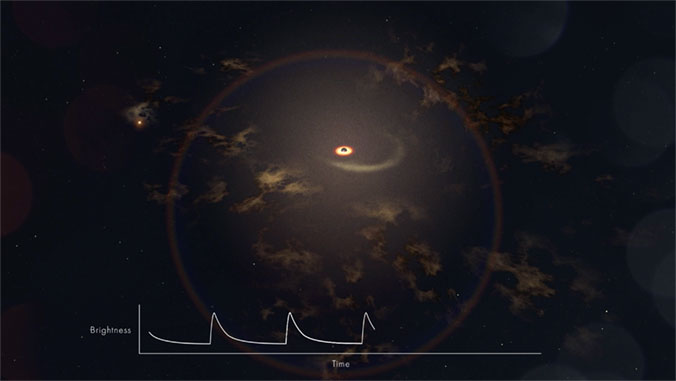
The centers of galaxies with actively feeding supermassive black holes are already astounding environments. Now, a team of researchers led by a graduate student from the University of Hawaiʻi Institute for Astronomy (IfA) has found an even more interesting oddball. Feeding black holes typically increase and decrease in brightness similar to the Kīlauea volcano on Hawaiʻi Island, becoming more or less active over time in unpredictable ways. However, the newly discovered black hole is more like Old Faithful geyser at Yellowstone National Park, erupting repeatedly at predictable times.
Astronomers classify galaxies with unusually bright and variable centers as active galaxies. The active centers can produce much more energy than the combined contribution of all the stars in the host galaxy. The excess energy can be seen at visible, ultraviolet and X-ray wavelengths. Astrophysicists think the extra emission comes from near the galaxy’s central supermassive black hole, where a swirling disk of gas and dust accumulates and heats up because of gravitational and frictional forces. The black hole slowly consumes the material, which usually creates low-level, random changes in the disk’s emitted light.
Flaring galaxy
However, a repeatedly flaring galaxy was first detected in 2014 by the All Sky Automated Survey for Supernovae (ASAS-SN) 14-cm telescope at Haleakalā Observatory on Maui. Headquartered at Ohio State University, ASAS-SN scans the entire sky every night using telescopes around the world, looking for exploding stars, stellar flares and comets. The galaxy, ESO 253-3, is a known active galaxy more than 570 million light-years away in the southern constellation Pictor. At the time, astronomers thought the outburst was most likely a supernova, a one-time event that destroys a star.
The periodic flares then went undetected until 2020 when NASA Graduate Fellow Anna Payne at IfA discovered them in the ASAS-SN data as part of her doctoral thesis studying active galactic nuclei. She found that the center of the galaxy ESO 253-3 periodically emits a bright flare, every 114 days. Periodic flares in active galaxies have been sought previously but never before been detected this unambiguously and found to occur so often.
“This is the first clear example of recurring multiwavelength flares from a galaxy’s core that happen this frequently,” said Payne.
Led by the UH team, an international group of astronomers used several other observatories to further reveal the complexity of these flares. Their study combined data from ASAS-SN, UH’s Asteroid Terrestrial-impact Last Alert System, NASA’s Neil Gehrels Swift Observatory, NASA’s Transiting Exoplanet Survey Satellite, the Las Cumbres Observatory (including telescopes at Haleakalā Observatory) and amateur astronomers from around the world. Payne’s analysis found that the flares happen not only in the visible wavelengths, but also at higher energy X-ray and ultraviolet wavelengths.

